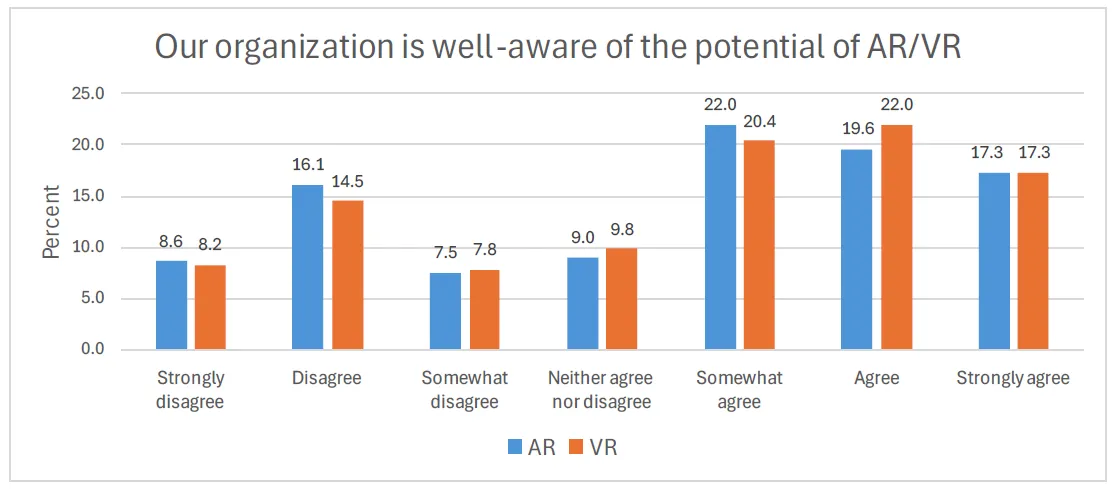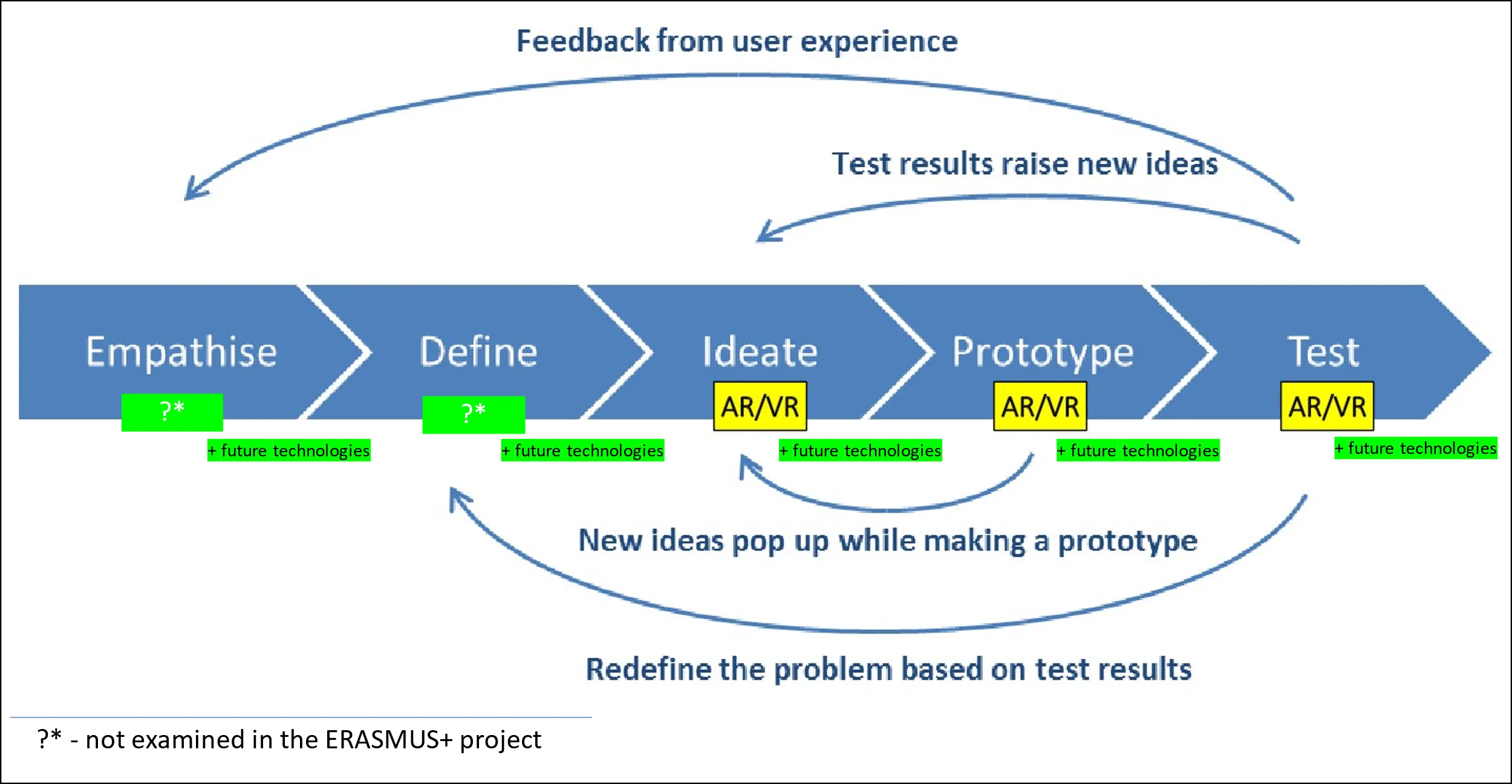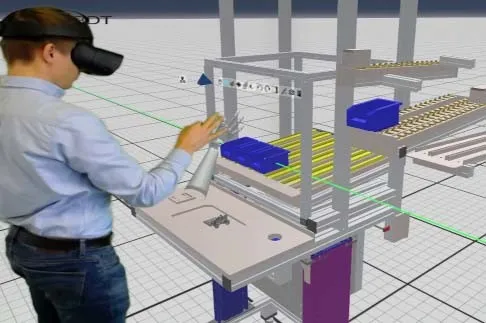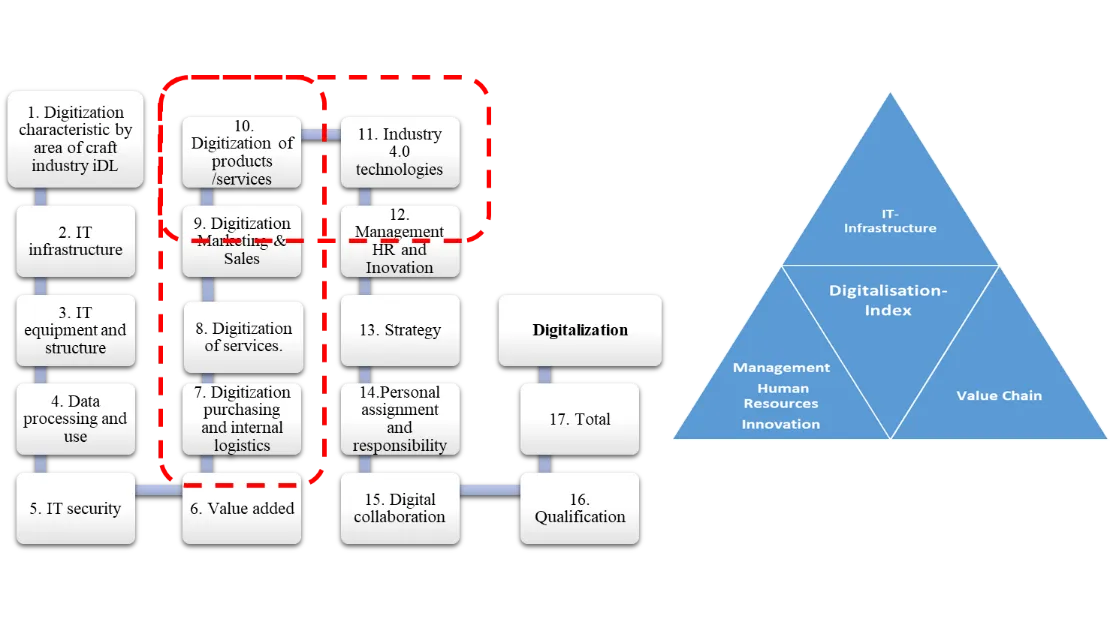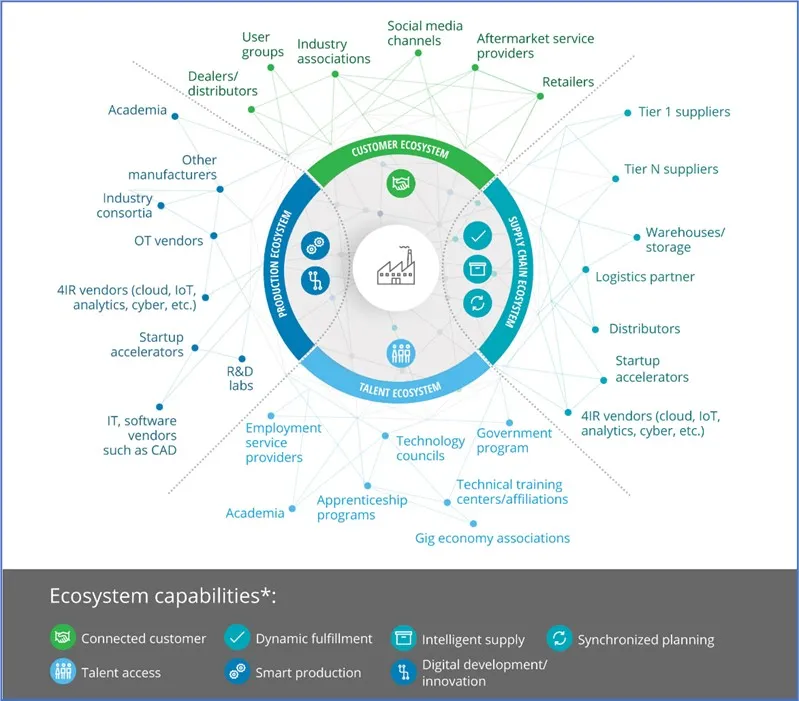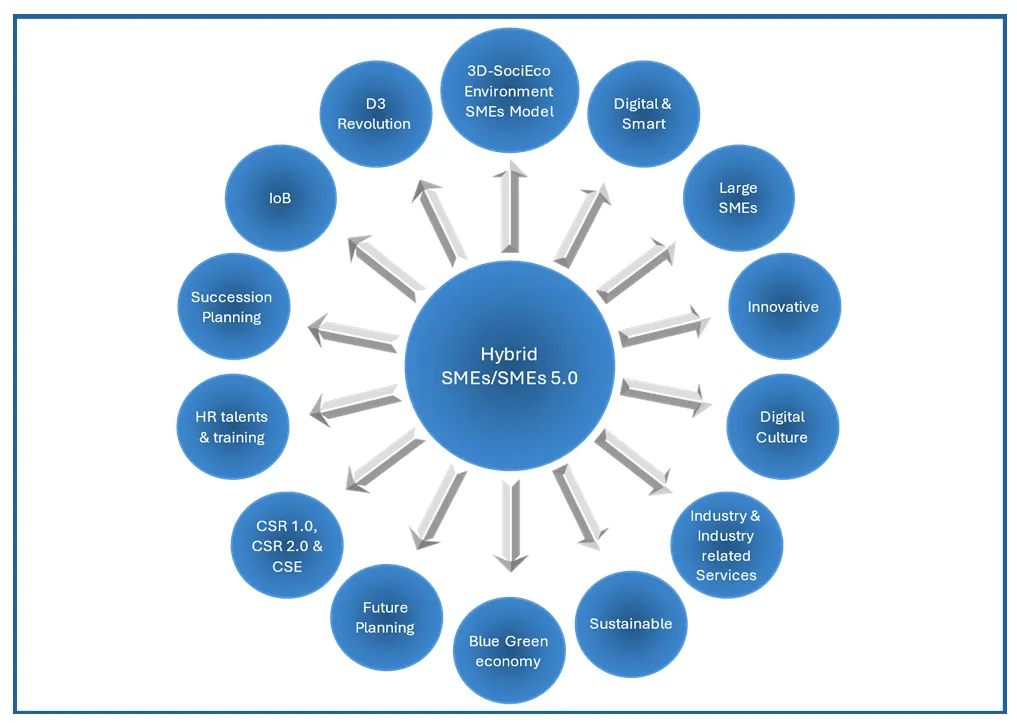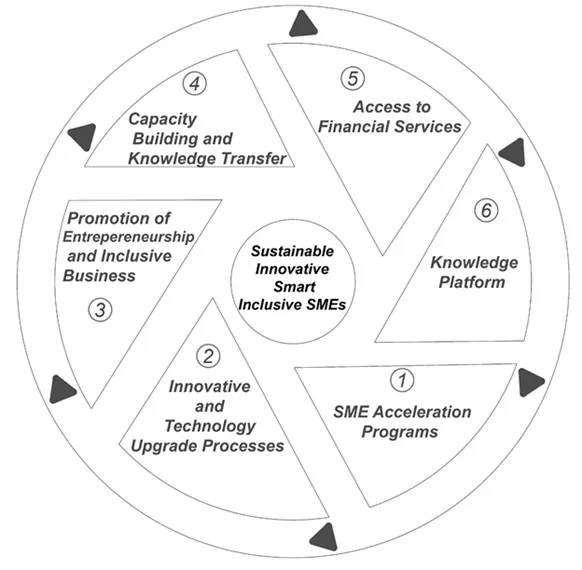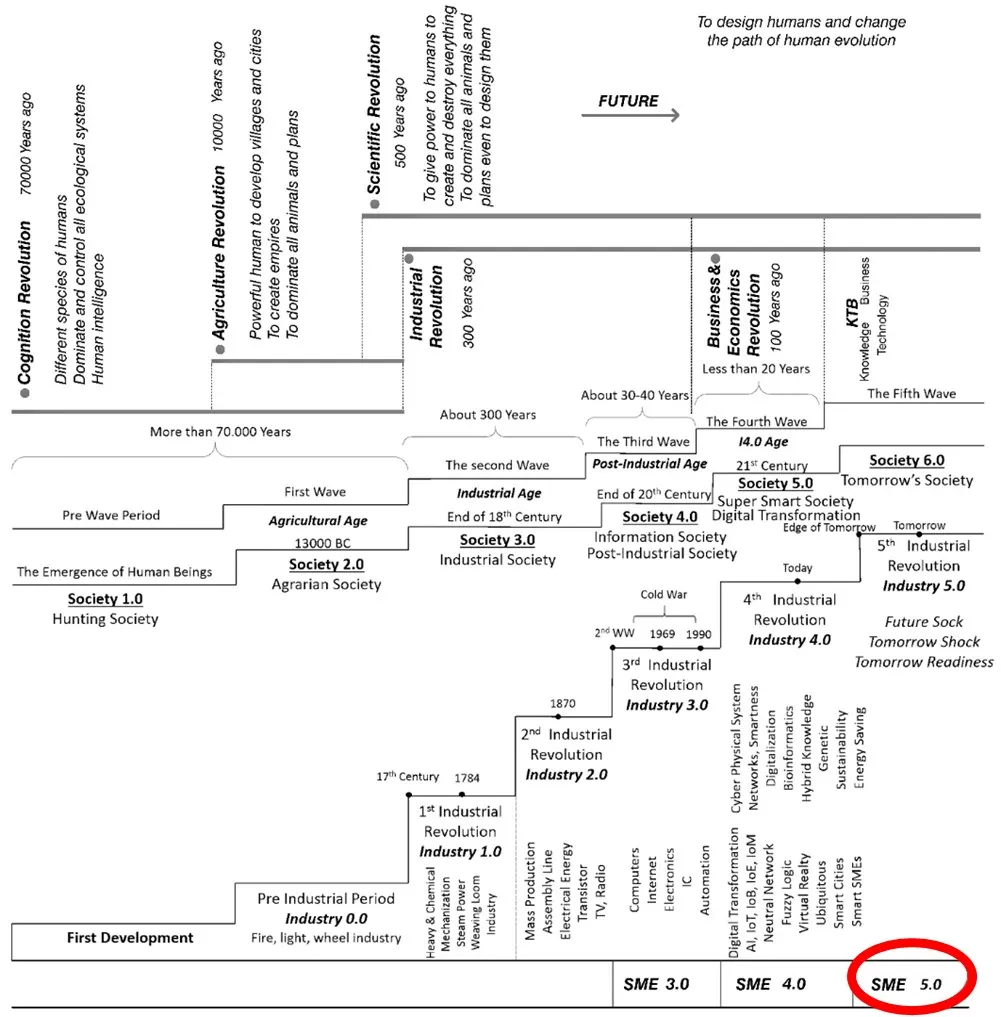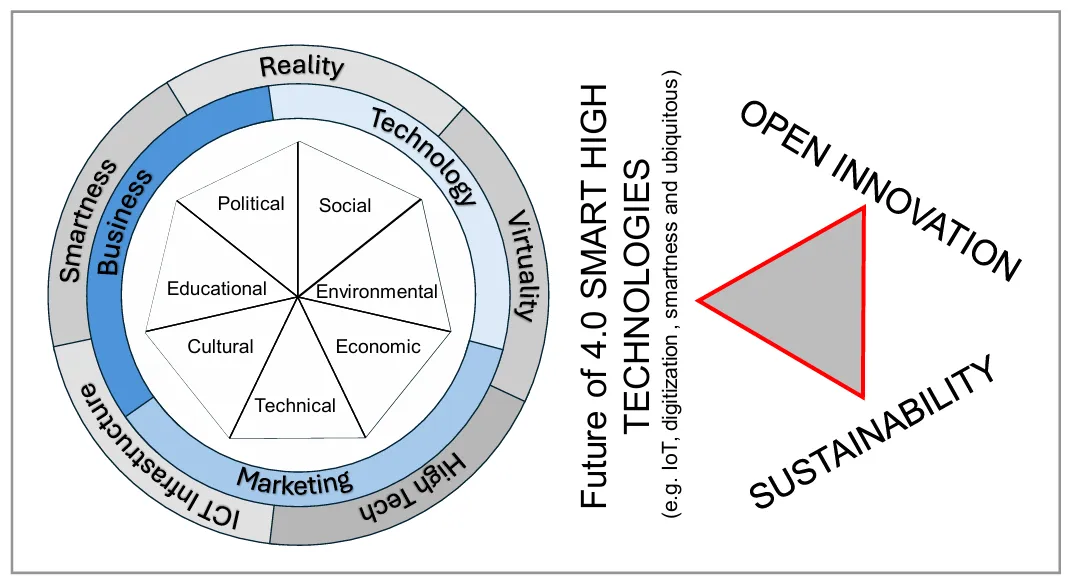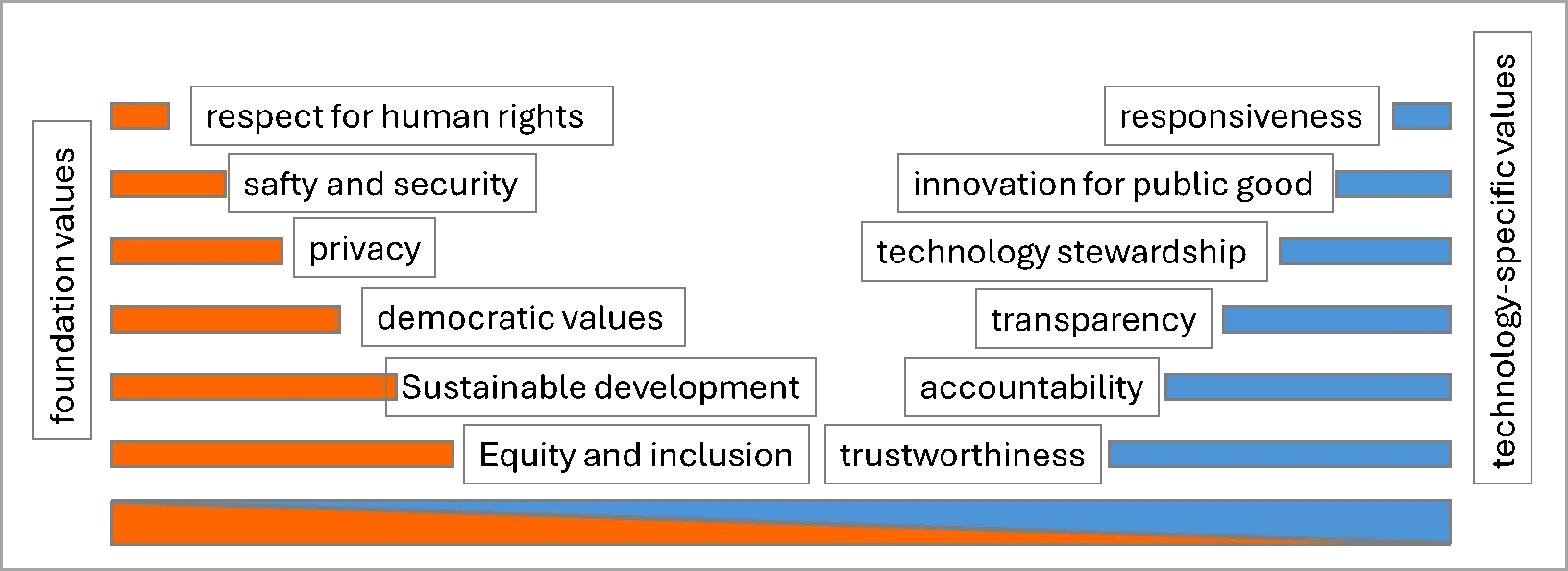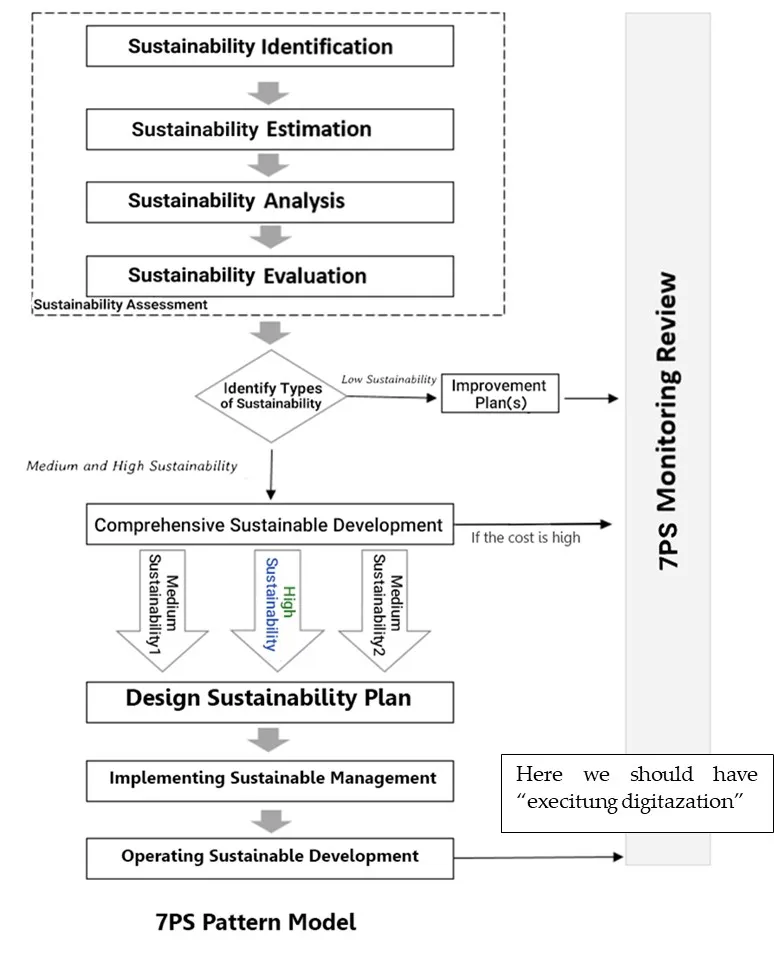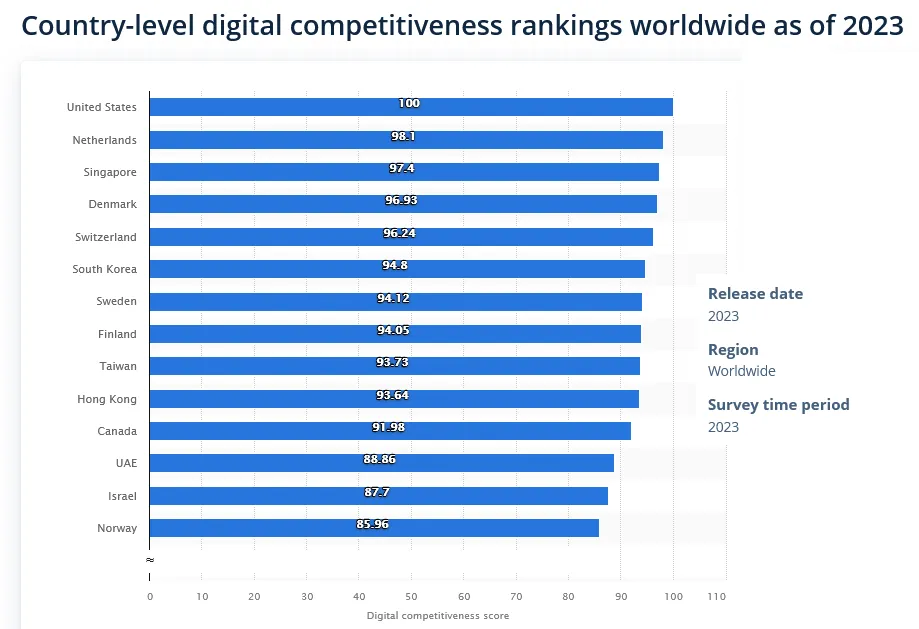Part of Special Issue
The X.0 Wave/Tomorrow Age Theory: Sculpting the Future of Civilization
Download PDF
Cite This Article
Contents
1. Introduction
2. The Role of New Technologies in Today’s Business
3. Legal and Regulatory Challenges
4. Digital Collaboration
5. The X.0 Wave/Tomorrow Age Theory or Theory of Comprehensive Everything
6. Adaptation Approaches for Practice
7. Advantage and Novelty—New Business Concepts Become Possible
8. Results and Discussion
9. Conclusions and Future Suggestions
Author Contributions
Ethics Statement
Informed Consent Statement
Funding
Declaration of Competing Interest
References
Overcoming SME Legal and Regulatory Challenges and Fostering Sustainable Collaboration and 7PS Engineering in the Digital Age through Integrating the X.0 Wave Theory & SME 5.0 Concept
Author Information
Other Information
Department of Economics, FHM University of Applied Sciences, Ernst-Reuter-Platz 3-5, 10587 Berlin, Germany
*
Authors to whom correspondence should be addressed.
Received: 21 July 2024 Revised: 31 July 2024 Accepted: 21 August 2024 Published: 28 August 2024
© 2024 The authors. This is an open access article under the Creative Commons Attribution 4.0 International License (https://creativecommons.org/licenses/by/4.0/).
Intell. Sustain. Manuf.
2024,
1(2), 10011;
DOI: 10.35534/ism.2024.10011
ABSTRACT:
Technological
innovations, education, business and society change quickly and often
unpredictably. The fusion of artificial intelligence (AI), machine learning,
augmented reality (AR), virtual reality (VR) and augmented reality (XR) opens a
new era in which work, production, communication and thought processes are
massively transformed. In this context, the challenge arises: How can small and
medium-sized enterprises (SMEs) adapt to this accelerated change? This study
highlights a path forward and introduces the concept of “SME 5.0” or “Hybrid
SME” or “SME of Tomorrow” as a comprehensive solution to address the
complexities of the digital age. In this integrated exploration of the X.0 Wave
Theory and SME 5.0 Concept, the framework for human civilization’s evolution
and technological shifts converges with a practical roadmap for small and
medium-sized enterprises (SMEs) navigating the dynamic digital landscape.
Acknowledging transformative waves in technology, economics, and societal
structures within the X.0 Wave Theory, the study accentuates the ongoing nature
of these shifts. It advocates for a long-term perspective, urging policymakers
and industry leaders to consider potential future scenarios to devise
strategies fostering innovation, competitiveness, and privacy safeguards.
Simultaneously, the study introduces SME 5.0 as a holistic solution for SMEs,
aligning with the transformative success envisioned by the X.0 Wave Theory.
Proposing the Seven Pillars of Sustainability (7PS) framework tailored to SMEs,
the concept emphasizes digitalization and sustainable technology. The title, “Harmonizing
the X.0 Wave Theory and SME 5.0 Concept”,
encapsulates the synergy between theoretical underpinnings and practical
solutions. The subtitle, “Fostering Sustainable Collaboration, 7PS Engineering,
and Overcoming Legal Challenges in the Digital Age”, provides a glimpse into
the study’s focus on practical implications, sustainability, engineering, and
legal considerations for SMEs in the rapidly evolving digital era.
Keywords:
SME 5.0/Hybrid SMEs or Tomorrow’s SMEs; Sustainable
Collaboration; Emerging Technologies; 7PS Sustainable Engineering; Digital Age;
SME Legal and Regulatory Challenges; Digitalization; AI; VR; XR; AI; SME; 7PS
Model; X.0 Wave/Age theory; i-Sustainability Plus theory
1. Introduction
In the rapidly changing world of digitalization, where technological advancements constantly reshape education, business, and society, traditional research methods are quickly becoming outdated and increasingly irrelevant [1]. The fusion of artificial intelligence (AI), machine learning, augmented reality (AR), virtual reality (VR) and augmented reality (XR) has ushered in a new era in which work, production, communication and thought processes take center stage and are massively transformed. In this context, the challenge arises: How can small and medium-sized enterprises (SMEs) adapt to this accelerated change?
The answer can be simple but tailored innovation management. According to older understanding, specifically STAUDT 1990 [2], the barriers to innovation (see above) can be successfully overcome by:
- the condition of the system receiving the technical innovation, i.e., the applying company itself, which is embedded in a local, regional, national (infrastructure, labor market, access to sources of knowledge) and beyond environment (state, legal area, internationality),
- the starting position of the provider of the innovation, the way of its activities to communicate innovations and adaptation possibilities to potential users, as well as
- the most concrete possible presentation of the specific characteristics of the innovation or its specific advantages over existing solutions.
2. The Role of New Technologies in Today’s Business
The number of economic explanatory models, thought patterns, and developments, are diverse [5]. The visualized interpretations have often become known as wave models and usually capture trends or document trigger points [6,7]. Guaranteed successes and sustainable economic options cannot be derived directly from this because the models focus on time, intervals or level differences. The two-dimensionality is not useful in the context envisaged here because the uncertainties that are then ignored are not considered to be necessary boundary conditions. This article does not detail the various innovation theories and innovation waves because they only partially implement the inward and outward-directed innovation capability (and the inherent destructive potential). The fundamental importance and positive response of this theoretical approach remain unaffected.
Activating innovation-relevant elements in an organization is an essential task at the management level to ensure connectivity to market developments. “An organization’s valuable resources include, for example: financial resources, technological infrastructures, manufacturing processes, knowledge structures, customer communities, employees and their capabilities, legal framework conditions, reputation, and trust. Such resources are not to be taken for granted. Instead, they must first be identified, assessed, and mobilized, i.e., made into a resource of organizational value creation” ([8], p. 62).
The challenge, however, is only to a limited extent identifying these (internal) resources. The focus and practical origin of value creation is the combinatorial capability of an organization. This means bringing the resources required in each case into a logical and value-creating connection with one another in terms of time and content. RÜEGG-STÜRM/GRAND speaks here of the configuration (or the ability to do so) according to which resources cannot be mobilized for value creation in isolation. Still, only an organization-specific interaction (always unique) constitutes the connection of knowledge bases, talents and infrastructure and is also characterized by this ([8], p. 63).
With regard to collaboration with third parties, cooperation and collaboration, the concepts mentioned above are only partially effective due to their level of abstraction. They are therefore often no longer adopted by SMEs. The access gap to new things (methodological-structural and technical-technological) is becoming increasingly larger and the persistence in old patterns of thinking, values and decision-making processes is devastating. Statements about a lack of professional qualifications, a shortage of skilled workers, a lack of access to knowledge sources, etc., are typical side effects [9]. Research into the causes and impact assessments is therefore essential.
One possibility (help for self-help) is to focus on the environment, identify partners and initiate partnerships. There is always an idea at the beginning of a cooperation/collaboration. The idea’s viability (the search fields) is based on the concrete interests of the idea generators, the expected problems to be solved and an overarching goal [10]. Well-known innovation, technology and other wave models can be helpful here for initial orientation [11,12].
The following discussion focuses on the revitalized technology trend of virtual reality and advanced SME-oriented implementations.
2.1. Awareness and Preferences of SMEs Regarding AR, MR and VR
The literature is comprehensive and, in many respects very meaningful concerning the necessity of internet-based digitalization with the accompanying change in management models. However, it is still interesting to find out which parameters can impact success as driving forces, or at least as a driving force [13]. In abstract terms, the authors are concerned with whether emerging technologies and related tools are an absolute must or whether emerging technologies are rather useful and important tool. The impulses for the thoughts presented below come from two different research projects. Firstly, the X.0 wave theory and, secondly, from two ERASMUS+ programs that have been dealing with digitalization, emerging technologies trends and corporate culture since 2018.
The starting point for a modern ICT-oriented business activity should focus on Augmented Reality (AR), Virtual Reality (VR), and Mixed Reality (MR)—collectively known as Extended Realities (XR).It can be assumed that it is very likely that significant changes and innovations will have to be implemented by the industry within a decade [14].
Despite the hype around emerging technologies, many manufacturing SMEs are still not sufficiently aware of the potential of these technologies, how they could be used to support their business processes, or what challenges they might face in adopting these technologies. The VAM Realities European Survey [15] found that companies are aware of these technologies but have weaknesses in generating ideas, where and how they could be used and what factors determine the added value, for example, to promote return on investment. The online survey and interviews referenced here were conducted across Europe between April 2020 and October 2020 with 255 anonymous respondents and 46 interviews with selected medium-sized companies. The driving questions of the research made it clear that although SMEs in Europe knew emerging technologies, they did not have an explicit idea of deployment scenarios, restrictions and benefits. See Figure 1.
Result: It was confirmed that emergent technologies play an increasingly central role in many companies. It was also confirmed that technological and market developments must be pursued on one’s responsibility ([15], p. 11).
However, the actual use cases and implementation preparations are completely inadequate; approx. 60% of the basic quantity surveyed has never used AR/VR. SMEs have an enormous amount of catching up to do to be able to compete ([15], p. 12).
Respondents stated (around 35–40% of respondents either agreed or partially disagreed) that there are significant restrictions on the use of AR or VR in their companies. And that is an unexpectedly contradictory result, reflecting expectations and assumptions that small and medium-sized companies should be flexible and open here. The results show a rather wait-and-see, almost hesitant attitude. Overall, there is only a partially self-determined and reflected range of skills here.
It was found that connectivity with existing and different information systems represents a barrier to acceptance. However, technical, not legal, problems were affected ([15], p. 22). As expected, the lack of human resources was confirmed. As a way out of the dilemma, outsourcing was at least considered as an option ([15], p. 26). This would then concern a supposed shift in technical and legal responsibilities. The results from the aforementioned EU project show that emerging technologies are being targeted by the SME’s, and a natural reluctance accompanies the scenario. Internal and external interface management are well-known challenges. Advantages in terms of cooperation and highly networked collaboration can only be vaguely formulated. Clarification and knowledge transfer are necessary here.
2.2. Implications for Manufacturing & Communication
Based on the abovementioned experiences, the Erasmus VAMs project considers how modern technologies (again specifically AR, VR and XR) can be embedded into existing business models or process structures. The graphic below illustrates how the new technologies can be placed in a very simple way. See Figure 2.
It’s important to note that, depending on the perspective or specific needs, these technologies can be further enhanced by other factors, such as networking, legal regulations, or new types of interfaces with partners. At the same time, the graphic also makes it clear that feedback can occur in a very simple, quick way between the people involved or at a very abstract level, elements of the various systems involved. In concrete terms, this means either between people from one company who work together in a team, between people from 2 different companies or beyond in larger network structures. The latter can also be a variant in which, for example, a university teacher is communicatively connected with students and experts from industry in a virtual world to discuss the process chains shown here in very specific detail. Different perspectives come together in real-time, cooperatively and collaboratively. This compression can also be specified in more detail using the acronym SCAMPER (Substitute, Combine, Adopt, Modify, Purpose or Put to another use, Eliminate, Reverse or Rearrange) ([16], p. 52). Some discussion points are summarized and presented in a compressed form below. The detailed content can be found in the aforementioned ERASMUS+ Project VAMR∗S. (See Internet: https://www.vam-realities.eu/wp-content/uploads/VAM-Realities_UBC_Handbook.pdf, last access 15 October 2023; 10:00 a.m.) The following Figure 3 visualizes the arguments mentioned above. Furthermore, it becomes clear that the potential danger of information leakage cannot be underestimated just by looking at this image. Both from the communicative context, which is presented in the form of language and visualization, information facts can also be used for other purposes from a significantly expanded context. In certain situations, the outflow of data and information from a paper-based communication process can be restricted by regulations, such as a copy ban. The contextual reference would also be clearly defined in this case. In the virtual space, however, all the senses of those involved are activated on a very concrete working level. In the positive case, this leads to fantastic new ideas, but on the other hand, it can also lead to an outflow of ideas. This is the source of fear and resistance on the part of SMEs when dealing with new technologies. The simple fear of loss of direction and control. The question is how these potential resistances can be identified, evaluated, made manageable and conversely, implemented positively.
Finally, here are a few key questions think about AR/VR/XR-based collaboration ([17], p. 104):
Figure 3. Perform design reviews more easily and more frequently with Virtual Reality. Source: https://xr-easy.com/use-cases/design-review, last access 15 October 2023, 11:00 a.m.
- What are the most critical communication bottlenecks in your company?
- How could AR/VR/XR be used to solve these bottlenecks?
- Who are the key people in your organization who could benefit from using AR/VR/XR in collaboration?
- What are the key digital assets in your organization that could be used in XR?
- What collaborative workflows could be transferred to AR/VR/XR environments?
- Which levels of detail should be made visible?
- How can the rules for binding and protecting intellectual property rights be activated before communication begins?
3. Legal and Regulatory Challenges
With the increase in internet-based means of communication and channels, the requirements for collecting, storing and further processing data are increasing. This not only affects the factual data and information levels but also the collection of data about the groups of people involved. In the end,, it’s about who the owner of the data is, who is allowed to save it, how and who has what access. A discussion about the European General Data Protection Regulation (GDPR), the lengthy implementation and activation of which should not be opened at this point but should indicate that both the idea and implementation differ massively from one another.
Every organization that deals with such new technologies of communication and cooperation must be aware that there are various laws and regulations regarding authorship, operator rights and usage rights.
Many SMEs do not necessarily face an “awareness” problem regarding the EU General Data Protection Regulation (Regulation 2016/679/EU—“GDPR”), it is rather a problem of “capacity” for them. According to a report on the SME experience of the GDPR, a large number of SMEs may be lacking the resources to be able to compete and be compliant at the same time ([18], pp. 95–116).
Another kind of data that need consideration in terms of data privacy is non-verbal data. In the legal framework, the responsibility and concerns of such sensitive data are yet to be acknowledged. Developing algorithms, for example, based on individual body language or user responses in events within the application may “have value outside of VR because it is fairly simple, even using older technology, to capture and categorize body movements in the real world using computer vision” ([18], p. 115). When it comes to data security, VR systems are currently dependent on third-party services or applications. The implementation of security standards must, therefore, be your responsibility. The concern that the data could be made accessible to unauthorized personnel is still justified. In addition, data security covers another problem for companies, namely data compromise to data loss due to an external disaster (fire, flood, etc.). Security measures are essential to ensure business continuity and reliable (re)introduction. This leads to an extensive dependency on virtual data formats. This can also require a capital-intensive infrastructure to ensure data security otherwise important services could no longer be provided in an emergency ([18], p. 116).
4. Digital Collaboration
The process of digitizing businesses extends beyond the technical realm; it’s a strategic and corporate-cultural transformation. This shift calls for skilled professionals and individuals who can spearhead digital initiatives. Equally important is the need for employees to become well-versed in digital technology. The Digitization Index, which pertains to management, human resources, education, and innovation, spans three critical dimensions:
The current challenges call for a fundamental shift away from traditional modes of thinking. The business landscape has transformed into a complex, interconnected network comprising diverse stakeholders.
In our increasingly globalized world, factors like geographic locations, borders, and time zones remain relevant but have become more flexible. The figure below vividly portrays this transformed landscape’s emerging management priorities and focal areas.
All the points mentioned above are succinctly summarized in Figure 5.
Effective management systems for SMEs must accurately depict dynamic environmental influences to enable causal optimization of productivity and efficiency. Leadership, distinct from management, plays a pivotal role in driving a business’s success and high efficiency. Leadership involves convincing others to achieve the company’s defined goals and communicating new horizons, creating space for creativity, identifying opportunities, and realizing innovative ideas.
The relationship between entrepreneurship and innovation is essential for creating and enhancing new businesses, thus capitalizing on economic opportunities. Integrating innovation into various facets of businesses, including processes, management, finances, training, and more, can facilitate the growth and sustainability of SMEs.
Sustainable entrepreneurship aligns with the individual goals pursued by business owners. Key parameters, including social responsibility, long-term competitiveness, progressiveness, knowledge utilization, continuous innovation, and addressing environmental challenges, contribute to a sustainable economy. Innovation, management, leadership, economic behaviors, education, and intellectual capital are indispensable for fostering sustainable SMEs. Furthermore, the rapid growth of urbanization underscores the need for businesses to adapt to modern urban requirements. Leveraging high technology, such as digitalization and Industry 4.0, empowers SMEs to keep pace with urbanization trends and drive sustainable business success. Figure 5 visually captures these essential aspects. Whether operating at a local, regional, or global level, technologies and concepts such as IoT, Industry 4.0, or Industry X.0 naturally introduce new modes of transfer and exchange. Flexibility, secure handling, risk management, and unwavering determination facilitate implementation.
Achieving success in the utilization and implementation of Industry 4.0 technology depends on well-defined value-sharing structures, interconnected process chains, access to knowledge sources, modern work environments, and a pioneering role in technical and technological aspects. These factors can serve as the linchpins for hybrid SMEs to realize the full potential of Industry 4.0. Supposedly, hybrid SMEs can benefit from shifting their focus toward product innovation by utilizing new technologies. Competitive environments tend to encourage innovation in products and services. Therefore, implementing policies that reduce constraints and foster innovation can lead to enhanced performance and value creation for SMEs. Alongside market-oriented strategies and competitive structures, the unique characteristics of a company also play a vital role in driving innovation.
4.1. SME 4.0 to SME 5.0/Hybrid SMEs/Tomorrow’s SMEs
4.1.1. SME 4.0
SMEs are tasked with identifying innovative solutions and technologies to meet customer needs. The integration of customers into these communication loops is a highly personalized process and offers a crucial advantage, especially for SMEs. Subsequently, the adaptation of technologies and customization to specific needs becomes imperative. Whether operating at a local, regional, or global level, technologies and concepts such as IoT, Industry 4.0, or Industry X.0 naturally introduce new modes of transfer and exchange. Flexibility, secure handling, risk management, and unwavering determination facilitate implementation.
Achieving success in utilizing and implementing of Industry 4.0 technology hinges on well-defined value-sharing structures, interconnected process chains, access to knowledge sources, modern work environments, and a pioneering role in technical and technological aspects. These factors can serve as the linchpins for SMEs in realizing the full potential of Industry 4.0.
4.1.2. SME 5.0/Hybrid SMEs/Tomorrow’s SMEs Concept
This paper defines hybrid SMEs as a unique form of ambidextrous organization. On one side, they are dedicated to fostering cultural, environmental, social, economic, technical, political, and educational goals. On the other side, they can engage in business activities and generate revenue.
Essentially, IoT, digitalization and intelligent education management serve as effective tools and sources of motivation for improving HR competencies in modern, hybrid SMEs. In the present discussion, this combines the development stages Industry 5.0 and SME 5.0.
Figure 6 illustrates the two wings of these SME 5.0 organizations, highlighting their dual nature and ambidextrous approach to combining mission-driven goals and revenue-generating capabilities.
Absolutely, SMEs can certainly benefit from shifting their focus towards product innovation by utilizing new technologies. Competitive environments tend to encourage innovation in products and services. Therefore, implementing policies that reduce constraints and foster innovation can lead to enhanced performance and value creation for SMEs. Alongside market-oriented strategies and competitive structures, the unique characteristics of a company also play a vital role in driving innovation.
Moreover, the strategies encompassing CSR 1.0, CSR 2.0, CSE, and CGS can provide a viable path for businesses to navigate contemporary challenges and anticipate future crises. To foster product innovation, it’s crucial to emphasize market dynamics and education rather than relying solely on technology.
The X.0 wave theory, developed further, conceptually shows the “SME 5.0/Hybrid SME” or “SME of tomorrow” that has a number of unique characteristics:
- Strategy: Defining the strategic framework for digital integration.
- Ownership and Accountability: Identifying the key drivers and responsible parties for digital projects within the organization.
- Qualification: Actively equipping employees with the necessary digital skills and competencies.
Figure 4. Digitalization Dimensions & Digitization index by industry. Source: (own source, FHM University project).
Figure 5. Connected participants and capabilities in a smart manufacturing ecosystem. Source: https://www2.deloitte.com/us/en/insights/industry/manufacturing/accelerating-smart-manufacturing.html, 19 December 2021, 02:15 p.m.
- 3D Socio-Eco-Environment Model: Prioritizing responsibility towards the environment (Environmentally Responsibility), fostering social cohesion (Social Cohesion), and ensuring economic efficiency (Economic Efficiency).
- Develop a comprehensive cybersecurity governance policy encompassing risk management strategies and technical controls.
- Implement the necessary tools, skills and resources for threat detection and response.
- Conduct regular cybersecurity assessments to identify vulnerabilities.
- Train employees in cybersecurity best practices.
- Utilize cybersecurity ratings to assess the security posture.
- Foster a culture of cybersecurity awareness.
- Continuously monitor and update cybersecurity policies to stay ahead of emerging threats.
5. The X.0 Wave/Tomorrow Age Theory or Theory of Comprehensive Everything
The “X.0 Wave” or “Tomorrow Age” theory or or Theory of Comprehensive Everything, is a framework, see Figure 9, aimed at predicting and preparing for future challenges, crises, and opportunities in the context of a rapidly changing and technologically advancing world. This theory acknowledges that the world is undergoing significant changes, particularly with the advent of the fourth industrial revolution, characterized by digital technology and its far-reaching implications. The theory emphasizes the need for businesses and societies to anticipate future challenges, proactively take measures to prevent them, and effectively respond to crises. The timeline of this theory spans from 2020 to 2030 (which is first edge of tomorrow) and highlights the importance of innovation in addressing risks, threats, and crises.
The theory’s core principles include:
The hurdles of “bridging the gap” present a number of problems that can lead to further problem areas. Awareness, expected effectiveness and achievable application depth are just a few examples (see Chapter 2.1, p. 3). Therefore, practical approaches are needed that break down the complexity and diversity to a manageable level. Specifically, to the extent that technology and the company as a social unit with the people involved represent a value system with a long-term perspective.
Figure 9. The Industries and Societies at The X.0 Wave/Tomorrow Age Theory. Source: [own source].
- Anticipation: Identifying and predicting future challenges and opportunities.
- Prevention: Implementing measures to mitigate risks and challenges proactively.
- Adaptation: Being prepared to respond effectively to crises or disruptions.
- Embracing Innovation: Harnessing the power of digital and innovative technologies to thrive in a rapidly evolving world.
- A New Era: Humanity has progressed through the agricultural, industrial, and information ages and now stands at the threshold of a new era, referred to as the “4th Industrial Revolution” and “Tomorrow Age.” This era is characterized by digital technology and an unprecedented scale of complexity.
- Challenges and Crises: Challenges and crises, including the recent COVID-19 pandemic, play a role as “super accelerators.” They accelerate the need for innovative solutions and governance methods, turning threats into opportunities.
- Smart Governance: The 9PGS model, based on combining human factors, culture, management methods, and advanced technologies like AI and IoT, becomes essential for governments to address challenges and crises effectively.
- Sustainable Global Smart Governance: Governments must transition to a new governance model focused on innovation and sustainability. This model emphasizes creating public values through innovative, technology-driven approaches to improve human livability and quality of life.
- 7PS Model: The 7PS model encompasses the environmental, social, economic, educational, technical, and political dimensions influencing governance and innovation culture.
- Information and Communication Technology: Information and communication technology anddigital innovation culture, plays a crucial role in shaping sustainable governance and innovation in societies and organizations.
- High Sustainability: The 7PS model encompasses dimensions related to environmental responsibility, social cohesion, and economic efficiency, which are critical for sustainable governance and innovation.
- Analyzing Determining Factors: The research aims to examine and understand the impact of innovative culture, information technology, and digital innovation on the business sector’s sustainability. It analyzes factors that facilitate sustainable innovation in the context of high sustainability.
- Fuzzy AHP: The study uses the Analytical Hierarchy Process (AHP) technique and model to determine the priority of decision-making indicators and provide a structured sequence of goals, criteria, and sub-criteria to guide policymakers and decision-makers.
- Innovation: Innovation is the engine that propels sustainable development forward. It involves developing new technologies, processes, and systems that are both effective and environmentally and socially responsible.. This principle acknowledges that sustainable management necessitates continuous innovation to meet the ever-evolving challenges of our world.
- Sustainability: Achieving economic growth while safeguarding our environment and upholding social equity is the essence of sustainability. Balancing economic prosperity with environmental preservation and social justice is imperative. Sustainability is not a choice but an imperative for long-term well-being.
- Future Technologies (X.0 technologies): The i-Sustainability Plus Theory is forward-looking, recognizing the transformative potential of future technologies like artificial intelligence and robotics. However, it also acknowledges the need for prudent management of these technologies to ensure they align with environmental, social, and economic sustainability.
Figure 10. i-Sustainability Plus Theory—Extension. Source: [own source].
6. Adaptation Approaches for Practice
In today’s digital age, governance structures that align with existing business models and organizational structures tend to be more effective than introducing redundant or competing structures. While developing sustainability governance structures may require time and effort, it is instrumental in successfully managing ESG (Environment, Social, Governance) matters.
The 7PS package model is a practical example and, at the same time, a sufficiently comprehensive approach to combine different models with the seven pillars of sustainability and open up the perspective on technological sustainability using digital approaches. Figure 12 presents a modeling approach in this regard.
7. Advantage and Novelty—New Business Concepts Become Possible
The discussions in this essay have presented a wealth of models and starting points and made it clear that raising awareness of sustainability governance structures is an initial factor. Once the sustainability philosophy harmonizes with and improves existing business models and organizational frameworks, better results should be achieved. This would be an advantage over old and mostly competitive structures.
In this way, it becomes possible to delineate and contextualize the special technological and innovative aspects of our current times while addressing challenges and crises with a focus on quality of life and sustainability in different dimensions. These include politics, education, environment, social issues, economics, technology and culture. These insights provide the opportunity for novel identification, description, contextual classification and investigation.
Although the development of sustainability governance structures can require a significant amount of time and effort, it serves as a crucial mechanism for effectively managing ESG (environmental, social, governance) issues. Ideally, this does not exclude a reorientation and evaluation of profitability (beyond the mathematical function).
8. Results and Discussion
This article aimed to measure the impact of digitalization, business intelligence and artificial intelligence in creating a competitive advantage for small and medium enterprise entrepreneurs. The results indicate that artificial intelligence, as an advanced technology, can significantly contribute to creating a competitive advantage for companies. The most important way AI benefits businesses is by streamlining communication processes and simplifying tasks. However how to create this competitive advantage and use it is remarkable. In a situation where artificial intelligence seems to be a purely technical concept. Its impact on customer behavior analysis, which is one of the main competitive advantages of a company to gain a better position in the market, is very important. Additionally, giving entrepreneurs control over technical staff, such as programmers and those who use this technology, is important and can be seen as a way to enhance their knowledge.
8.1. The Study on “SME 5.0/Hybrid SMEs
Empowering Sustainable Collaboration with Emerging Technologies Towards 7PS Sustainable Engineering in the Digital Age, Addressing SME Legal and Regulatory Challenges” has yielded significant insights into integrating emerging technologies in SMEs, particularly in the context of sustainable engineering. The study has highlighted crucial results and their implications, which are discussed below:
1. Adoption of Emerging Technologies
The study found that a growing number of SMEs are adopting emerging technologies, which are collectively referred to as SME 5.0 or Hybrid SMEs. These technologies include IoT, AI, data analytics, and automation. The adoption of these technologies has been driven by the need for increased efficiency, competitiveness, and sustainability.
Discussion: The increasing adoption of emerging technologies in SMEs is a positive trend, as it enhances their capabilities to meet the demands of the digital age. This aligns with the principles of the 7PS model, particularly in terms of technical and economic dimensions. However, it also poses various challenges, including legal and regulatory issues, as discussed below.
2. Legal and Regulatory Challenges
The study identified several legal and regulatory challenges SMEs encounter when integrating emerging technologies into their operations. These challenges encompass data privacy, cybersecurity, intellectual property, and compliance with industry-specific regulations.
Discussion: Overcoming these legal and regulatory challenges is paramount for SMEs to ensure sustainability in the digital age. Data privacy and cybersecurity are essential for compliance but also for maintaining the trust of customers and partners. Addressing intellectual property concerns is vital for innovation and competitiveness. Compliance with industry-specific regulations is necessary to avoid legal repercussions.
3. Collaboration and Sustainable Engineering
A significant finding is the role of collaboration in achieving sustainable engineering. SMEs that actively collaborate with partners, suppliers, and customers can leverage emerging technologies for sustainable practices. This collaboration promotes resource efficiency, reduced environmental impact, and cost savings.
Discussion: Collaboration aligns with the social and environmental dimensions of the 7PS model, as it fosters social cohesion and environmental responsibility. SMEs should seek to establish partnerships and alliances to achieve shared sustainability goals.
4. Empowerment and Transformation
The adoption of emerging technologies empowers SMEs by increasing their competitiveness, efficiency, and capacity for innovation. The study revealed that SME 5.0 or Hybrid SMEs experience significant transformations, allowing them to take on larger, more complex projects.
Discussion: Empowerment and transformation align with the economic and technical dimensions of the 7PS model. Empowered SMEs can contribute to economic growth and technical innovation, furthering sustainability goals.
5. Future Prospects
The study suggests that SMEs that successfully navigate legal and regulatory challenges while capitalizing on the opportunities presented by emerging technologies are better positioned for future growth and sustainability in the digital age.
Discussion: Preparing SMEs for the future aligns with the 7PS model’s focus on education and innovation. This contributes to their overall socio-economic development.
The results indicate that SME 5.0/Hybrid SMEs have the potential to empower sustainable collaboration through the integration of emerging technologies. While they face legal and regulatory challenges, these can be overcome concertedly. Collaboration and sustainable engineering are critical for SMEs to thrive in the digital age and contribute to the 7PS model’s dimensions of sustainability. Ultimately, empowering SMEs in this manner has significant implications for communities’ socio-economic and environmental well-being.
In the end, the question remains as to where an ideal starting point for digitization and hybrid SMEs can be found. A look at the statistics alone, see Figure 13, is insufficient, as no details regarding politics, legislation, economy, funding, networking, etc. can be found.
The USA is the leading IT location in international comparison, followed by Singapore and the Scandinavian countries. Statistics of this kind provide reliable basic data, although the underlying details in terms of quantity and extent require individual examination and are also determined by the focus of interest.
In the context of the X.0 Wave/Tomorrow Age Theory, three countries are highlighted as examples where governments are actively removing legal and regulatory barriers to boost the digital development of SMEs and Hybrid SMEs. This approach is driving innovation and economic growth in the digital age.
Notable examples include:
1. Singapore
- Facilitation: The Singaporean government has introduced several initiatives to reduce regulatory barriers and promote digitalization among SMEs, such as the “SMEs Go Digital” program. This program provides SMEs access to digital solutions, funding, and advisory services to help them adopt and integrate digital technologies into their operations. Furthermore, regulatory sandboxes have been established to allow SMEs to experiment with new technologies and business models in a controlled environment without the risk of regulatory penalties.
- Effectiveness: The policy has effectively accelerating digital adoption among SMEs, improving their productivity and market reach.
- These efforts by the government have strengthened the SME sector, making it more resilient and competitive, and have helped establish Singapore as a global digital hub [28].
- Facilitation: Germany’s “Industrie 4.0” initiative is a prime example of how the government is facilitating the digital development of SMEs. The government has provided support through subsidies, grants, and access to research and innovation networks that help SMEs integrate Industry 4.0 technologies into their operations. The “Mittelstand-Digital” program also offers free resources and tools to help SMEs navigate digital transformation.
- Effectiveness: These policies have been effective in boosting the competitiveness of German SMEs in the global market by enabling them to adopt advanced technologies and innovate. For the state, this has strengthened the industrial base and sustained economic growth, reinforcing Germany’s leadership in industrial innovation [29].
- Facilitation: Estonia has been a pioneer in digital governance, implementing a range of policies designed to support the digital transformation of SMEs. The government has created a favorable regulatory environment through the “e-Residency” program, which allows entrepreneurs worldwide to establish and manage an EU-based company entirely online. Additionally, Estonia’s digital infrastructure, including the X-Road platform, enables secure and efficient data exchanges between SMEs and government services.
- Effectiveness: This policy has been highly effective in fostering a thriving digital economy, attracting international entrepreneurs, and enhancing the global competitiveness of Estonian SMEs. For the state, it has led to increased economic activity, innovation, and a reputation as a leader in digital governance [30].
9. Conclusions and Future Suggestions
The theory of the fifth wave describes a framework of ideas and a process model that links the complex issues of business, technology and society to such an extent that the digital transformation—here through AR/VR/XR technology—which is fraught with a certain degree of uncertainty, can be understood as a link. Understanding this requires a systematic analysis and identification of key tasks. The article also focuses on the Internet of Things, Internet of Everything and Intelligent Business. Identifying gaps, generating ideasand inventing and implementing them as genuine, market-launched innovations remain important for the medium-sized business landscape.
This also includes internal changes because advancing innovations requires extensive, business-oriented adaptation strategies. The pragmatic approach is to record the technical-technological and business management fundamentals—in the sense of an ad hoc state-of-the-art analysis—and, if necessary, derive individual learning and training programs and then establish them in the form of appropriate measures in the corporate and business culture. All of this together is already an internal innovation. The fifth wave theory helps create the conditions for self-description, questioning and collecting answers. The topic can be narrowed down in complexity with the keyword KTBat the highest level of the fifth-wave theory.
Again for comparison: classic, trend-based scenario analyses primarily identify trends, actor strategies, key factors, followed by specific scenario constructions. Disturbing factors have an imaginary effect (as an assumption) and lead to derived strategies. When using new and modern technologies, this is almost uncontrollable and brings further imponderables and uncertainties.
The fifth-wave theory takes a different approach. The focus is on networking or the activation of knowledge sources. The state-of-the-art analysis leads to a concrete level of knowledge (about the inside and the outside) that can guide thoughts towards a technical improvement or a trend reversal and, ideally, to identify new business cases. In this logical chain, strategy options, decision variants, and sustainability potential become visible. This visibility is undoubtedly also the starting point in terms of willingness to work, soft skills, technical skills and ultimately the ability to be successful as an entrepreneur. This comes close to a strategy of circular intervention [31].
It is, therefore, about adapting options, theories, tools and decision-making processes to one’s needs. Observations of the environment, continuous comparison and reflection of one’s identity as a company (of any size) play a role. In summary, one can say that this scope for decision-making, be it IoT (or other new technologies), must find a balance between risks, opportunities and necessities. In addition to assessing digitalization through IoT, there is also an identification of missing or incompatible software and hardware components. Knowledge sources should be activated and made usable using training and learning formats. Adaptability must be determined by adequate interface management, i.e., communication. With the help of the theory of the fifth wave, in the development phases of Society 5.0, trend development SME 4.0 towards SME 5.0, or KTB for short, these interfaces can be identified and derived as opportunities. Every form of digitization project should thus lead to sustainable success. It is important to document these steps (learning) and thus form a basis for future decisions (retrieving knowledge).
The study on the topic of “SME 5.0/Hybrid SME: Strengthening sustainable collaboration with new technologies towards 7PS Sustainable engineering in the digital age, overcoming legal and regulatory challenges for SMEs” offers valuable insights into the integration of new technologies in SMEs and their impact on sustainability and collaboration. This analysis highlights the importance of SME 5.0 or hybrid SMEs in achieving sustainable engineering practices and their potential to address complex challenges in the digital age.
Future Suggestions:
- Align SME research and economics, i.e., in higher education institutions, e.g., universities, re-align teaching and research with the majority ratios of economic substance, depending on the national economic constellation (see [32]).
- Legislation and regulatory support: Governments and regulators should consider developing SME-friendly laws and policies related to new technologies. This would help SMEs overcome legal challenges and optimize compliance (see AI legislative processes in Europe and investment volumes in global comparison [33,34]).
- Sustainable cooperation networks: Promote alliances and consortia that enable SMEs to share resources and knowledge related to sustainable engineering and new technologies over the longer term (5–10 years) rather than short-term market access/sales increases.
- Resource Allocation: SMEs should allocate resources for research and development related to emerging technologies. This investment can position them for long-term growth and sustainability.
- Novel, differently thought-out case studies: Industry associations should redefine case studies and best practices, away from positive success stories, towards critical reflections and provide more industry-specific adaptation models to encourage the integration of new technologies in SMEs. Help them help themselves with appropriate templates and tools.
- Global collaboration: Encouraging SMEs to engage in global collaborations and partnerships as this can provide access to resources and partnerships when these may not be available at the local level. Rethining support measures and financial incentive models for such engagement.
Author Contributions
Conceptualization, H.M. and C.D.; Methodology, H.M.; Formal Analysis, H.M.; Resources, H.M.; Data Curation, C.D.; Writing—Original Draft Preparation, H.M. and C.D.; Writing—Review & Editing, H.M. and C.D.; Visualization, C.D.; Project Administration, C.D.
Ethics Statement
Not applicable.
Informed Consent Statement
Not applicable.
Funding
This research (article) received no external funding.
Declaration of Competing Interest
The authors declare that they have no known competing financial interests or personal relationships that could have appeared to influence the work reported in this paper.
References
1.
Bundesnetzagentur für Elektrizität, Gas, Telekommunikation, Post und Eisenbahnen. Digitalisierung und ökologische Nachhaltigkeit in Unternehmen—Eine vergleichende Betrachtung von KMU und Großunternehmen (English: Digitalization and ecological sustainability in companies). Available online: https://data.bundesnetzagentur.de/Bundesnetzagentur/DE/Fachthemen/Digitalisierung/Mittelstand/Downloads/studie_langfassung.pdf (accessed on 15 August 2024).
2.
Staudt E. Die betriebswirtschaftliche Bedeutung von Innovation. In Handbuch des Wissenschaftstransfers, Schuster HJ, Ed.; Springer: Berlin/Heidelberg, Germany, 1990; pp. 202–203.
3.
Becker T, Dammer I, Howaldt J, Killich S. Netzwerke—praktikabel und zukunftsfähig. In Netzwerkmanagement—Mit Kooperation zum Unternehmenserfolg, 2nd ed.; Springer: Berlin/Heidelberg, Germany, 2007; p. 4.
4.
Ulrich H. Systemorientiertes Management; Haupt: Bern, Switzerland, 2001; p. 23.
5.
Silva R, Saraiva C, Mamede H. Assessment of Organizational Readiness for Digital Transformation in SMEs. In Proceedings of the International Conference on Industry Sciences and Computer Science Innovation. Procedia Comput. Sci. 2022, 204, 362–369. Available online: https://www.sciencedirect.com/science/article/pii/S1877050922007827 (accessed on 15 August 2024). [Google Scholar]
6.
Neufeldt D. Waves of Change: Understanding the Driving Force of Innovation Cycles. Available online: https://www.weforum.org/agenda/2021/07/this-is-a-visualization-of-the-history-of-innovation-cycles/ (accessed on 15 August 2024).
7.
Jia J, Durrani T, Chen J. The Innovation Waves in Mobile Telecommunication Industry; IEEE: 2018. Available online: https://ieeexplore.ieee.org/document/8486831/references#references (accessed on 15 August 2024).
8.
Rüegg-Stürm J, Grand S. The St. Gallen Management Model; Haupt: Bern, Switzerland, 2015.
9.
European Union. Available online: https://ec.europa.eu/commission/presscorner/detail/en/ip_24_1507 (accessed on 15 August 2024).
10.
Howaldt J, Ellerkmann F. Entwicklungsphasen von Netzwerken und Unternehmenskooperationen. In Netzwerkmanagement—Mit Kooperation zum Unternehmenserfolg, 2nd ed.; Springer: Berlin/Heidelberg, Germany, 2007, pp. 35.
11.
Gartner Group. Available online: https://www.gartner.com/smarterwithgartner/technology-and-business-in-2030 (accessed on 2 July 2024).
12.
Panetta K. 5 Trends Appear on the Gartner Hype Cycle for Emerging Technologies, 2019; Gartner Group, 29 August 2019. Available online: https://www.gartner.com/smarterwithgartner/5-trends-appear-on-the-gartner-hype-cycle-for-emerging-technologies-2019 (accessed on 15 August 2024).
13.
Doost Mohammadian H. The 5th Wave Theory. Available online: https://www.youtube.com/channel/UCiVaBbD5pKKXaXae0Fh080Q (accessed on 15 August 2024).
14.
Meer HM, Zwieten R. An SME Perspective on Open Innovation. In Competence Management for Open Innovation; Hafkesbrink J, Hoppe HU, Schlichter J, Eds.; Josef Eul Verlag: Köln, Germany, 2010; pp. 3–13.
15.
ERAMUS+ Project VAM Realities Project. Available online: https://vam-realities.eu (accessed on 15 August 2024).
16.
Martens I. How Virtual and Augmented Realities Can Support the Design Process in Manufacturing SMEs. In XR Technologies for Industrial SMEs: The VAMR's University-Business Cooperation Handbook; Fachhochschule des Mittelstands (FHM) GmbH University of Applied Sciences: Berlin/Bielefeld, Germany, 2022; p. 53. Available online: https://www.vam-realities.eu/wp-content/uploads/VAM-Realities_UBC_Handbook.pdf (accessed on 15 October 2023).
17.
Jalo H, Torro O, Pirkkalainen H. How Virtual and Augmented Realities Can Support and Enhance Collaboration. In XR Technologies for Industrial SMEs: The VAMR's University-Business Cooperation Handbook; Fachhochschule des Mittelstands (FHM) GmbH University of Applied Sciences: Berlin/Bielefeld, Germany, 2022; p. 104. Available online: https://www.vam-realities.eu/wp-content/uploads/VAM-Realities_UBC_Handbook.pdf (accessed on 15 October 2023).
18.
Savvides L, Zittis M. Legal & Regulatory Challenges Regarding VR, AR, and MR Applications. In XR Technologies for Industrial SMEs: The VAMR's University-Business Cooperation Handbook; Fachhochschule des Mittelstands (FHM) GmbH University of Applied Sciences: Berlin/Bielefeld, Germany, 2022. Available online: https://www.vam-realities.eu/wp-content/uploads/VAM-Realities_UBC_Handbook.pdf (accessed on 15 October 2023).
19.
Doost Mohammadian H, Langari Z, Castro M, Wittberg V. Smart Governance for Educational Sustainability: Hybrid SMEs & the 5th Wave Theory Towards Mapping the Future Education in Post-Covid Era. In Proceedings of the 2022 IEEE Global Engineering Education Conference, Tunis, Tunesia,28–31 March 2022, pp. 1916–1926.
20.
Trochim WTK. Research Methods Knowledge Base; Atomic Dog Publishing: London, UK, 2010.
21.
Bessant J, Tidd J. Innovation and Entrepreneurship; Wiley Publications: New York, NY, USA, 2011.
22.
Burger T. Entrepreneurship, Creativity and Innovative Business Models; Tech Publications: New York, NY, USA, 2012.
23.
Luger G, Stubblefield W. Artificial Intelligence: Structures and Strategies for Complex Problem Solving; X.0 ed.; The Benjamin/Cummings Publishing Company, Inc.: San Francisco, CA, USA, 2004.
24.
Doost Mohammadian H, Rezaie F. An Applied Comparative Study about Countries with Low Sustainability and High CO2-Emission and Advanced Sustainability Knowledge in Europe and Giving Practical Models to Improve and Implement Sustainability Solutions. In Proceedings of the 6th International Conference on Civil, Architectural and Environmental Sciences, Stockholm, Sweden, 19 June 2019.
25.
Hengst M, Sol HG. The Impact of Information and Communication Technology on Interorganizational Coordination. In Proceedings of the Hawaii International Conference on System Sciences, Maui, HI, USA, 6 January 2001.
26.
OECD Science. Framework for Anticipatory Governance of Emerging Technologies; Technology and Industry Policy Papers, No. 165, April 2024. Available online: https://www.oecd.org/content/dam/oecd/en/publications/reports/2024/04/framework-for-anticipatory-governance-of-emerging-technologies_14bf0402/0248ead5-en.pdf (accessed on 16 August 2024).
27.
STATISTA. Available online: https://www.statista.com/statistics/1042743/worldwide-digital-competitiveness-rankings-by-country/ (accessed on 16 August 2024).
28.
Infocomm Media Development Authority. SMEs Go Digital. Available online: https://www.imda.gov.sg/how-we-can-help/smes-go-digital (accessed on 16 August 2024).
29.
European Union. Digital Economy and Society Index (DESI) 2022—Germany; 2022. Available online: https://ec.europa.eu/newsroom/dae/redirection/document/88748 (accessed on 15 August 2024).
30.
European Union. Digital Economy and Society Index (DESI) 2022—Estonia; 2022. Available online: https://ec.europa.eu/newsroom/dae/redirection/document/88701 (accessed on 15 August 2024).
31.
Wilke H. Systemtheorie II: Interventionstheorie, 4th ed.; Lucius & Lucius: Stuttgart, Germany, 2005; pp. 124–126.
32.
European Union. Available online: https://single-market-economy.ec.europa.eu/smes_en (accessed on 15 August 2024).
33.
European Union. AI Act; 2024. Available online: https://digital strategy.ec.europa.eu/en/policies/regulatory-framework-ai (accessed on 15 August 2024).
34.
Chopra C. How Venture Capital is Investing in AI in the Top Five Global Economies—and Shaping the AI Ecosystem; World Economic Forum, 24 May 2024. Available online: https://www.weforum.org/agenda/2024/05/these-5-countries-are-leading-the-global-ai-race-heres-how-theyre-doing-it/ (accessed on 15 August 2024).

